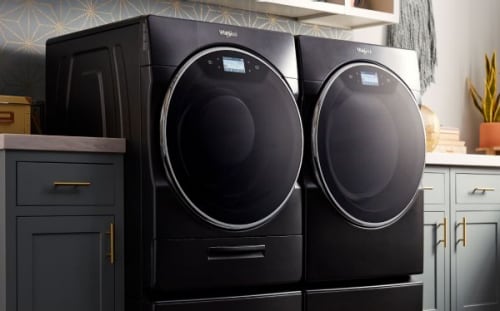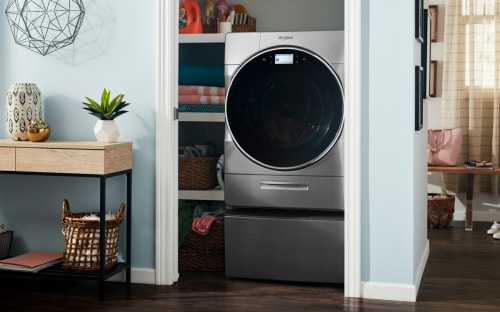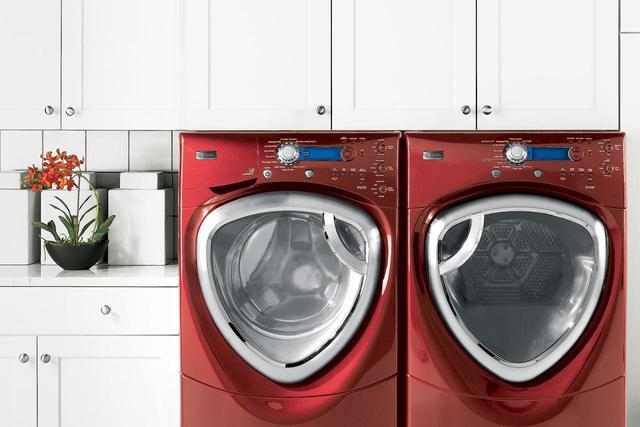Introduction
When Was The Clothes Dryer Invented – The invention of the clothes dryer revolutionized the way we handle laundry, offering a convenient and efficient solution to the age-old challenge of drying clothes. Prior to its creation, people relied on air drying or other labor-intensive methods to rid their garments of moisture. However, the emergence of the clothes dryer brought about a significant shift in laundry practices, making the process faster, more convenient, and more reliable.
The exact origins of the clothes dryer can be traced back to the early 19th century. The first rudimentary designs featured racks or lines on which wet clothes were hung to dry. However, these early drying methods were highly dependent on weather conditions and lacked the ability to expedite the drying process effectively.

The breakthrough in clothes drying technology came in the late 19th century when mechanical dryers were introduced. These early mechanical dryers were hand-cranked devices that utilized heat, typically generated by a fire or stove, to facilitate the drying process. While they represented a significant improvement over traditional methods, these early dryers were still relatively primitive and required considerable manual effort.
It wasn’t until the early 20th century that electric-powered clothes dryers began to gain popularity. In 1915, the first commercially successful electric dryer, known as the “Hamilton Electric Clothes Dryer,” was introduced to the market. This innovative appliance utilized electric heating elements to produce warm air, which was then circulated around the garments, expediting the drying process. The Hamilton Electric Clothes Dryer was a game-changer, offering convenience and time-saving benefits that were previously unimaginable.
Over the years, advancements in technology and design further refined the clothes dryer. Manufacturers introduced features such as automatic timers, temperature controls, and improved ventilation systems, enhancing the efficiency and effectiveness of these appliances. Today, modern clothes dryers come equipped with a plethora of innovative features, including moisture sensors, energy-saving settings, and delicate fabric care options, catering to the diverse needs and preferences of consumers.
When did people start using clothes dryers?
The History of the Clothes Dryer. We take dryers for granted, but it wasn’t too long ago that when clothes needed drying, we took them outside to hang on the clothesline. While their popularity grew in the 1950s, dryers didn’t really begin coming into their own until around 1960.
Clothes dryers, also known as tumble dryers, were invented to automate the drying process of laundry. The history of clothes dryers dates back to the early 19th century.
In the 1800s, people relied on manual methods such as hanging clothes outdoors or near a fire to dry them. However, this process was time-consuming and weather-dependent.
The first mechanical clothes dryer was patented in 1799 by a Frenchman named M. Pochon. This early design used a hand-cranked barrel that rotated the clothes over a fire. It was a significant advancement, but not widely adopted.
In the early 20th century, electric clothes dryers began to emerge. In 1915, J. Ross Moore invented the “Hamilton Automatic Clothes Dryer,” which used electric heat and a motorized drum. However, these early electric dryers were expensive and not accessible to the average household.
It was not until the 1930s and 1940s that clothes dryers became more affordable and popular. Manufacturers such as Maytag and General Electric started producing electric and gas-powered dryers, making them more widely available to the general public.
Since then, clothes dryers have continued to evolve with improvements in energy efficiency, drying technology, and additional features such as moisture sensors and wrinkle prevention settings.
Who invented the clothes dryer in 1971?
George T Sampson, Developer of America’s First Automatic Clothes Dryer.
There is no specific information or widely recognized inventor associated with the invention of the clothes dryer in 1971. It is important to note that clothes dryers existed long before 1971, with significant advancements made in the early 20th century.
In the 1970s, various manufacturers introduced improvements and innovations to clothes dryer technology. For instance, in 1973, Whirlpool Corporation introduced the first automatic clothes dryer with a moisture sensor. This sensor detected when clothes were dry and automatically shut off the dryer, preventing over-drying and conserving energy.
During this period, other manufacturers such as General Electric, Maytag, and Kenmore were also actively developing and improving clothes dryer models. These advancements included features like timed drying cycles, fabric-specific settings, and enhanced energy efficiency.
However, it is worth mentioning that multiple inventors and engineers contributed to the development of clothes dryers over time. The invention of the clothes dryer as we know it today was a gradual process involving numerous innovations and refinements throughout history.
What came first the washing machine or the dryer?
The first automatic, electric clothes washer came on the market in 1937, with electric tumble dryers appearing on the market a year later. Since many houses of the time were not designed with these appliances in mind, they were placed in existing rooms with adequate plumbing and electrical supply.
The washing machine predates the clothes dryer. The concept of mechanized clothes washing emerged earlier than the invention of clothes dryers.

The first washing machines were hand-operated and appeared in the late 18th century. One notable example is the “Scrub Board” or “Washboard,” which consisted of a wooden board with ridges used for scrubbing clothes. Over time, various mechanical advancements were made, such as the development of hand-cranked drum-style washing machines.
In the late 19th century, electric-powered washing machines were introduced, which marked a significant advancement in laundry technology. These machines featured electric motors to agitate and rotate the clothes inside a tub filled with water and detergent.
Clothes dryers, on the other hand, came into existence as a separate appliance after the washing machine. In the early 20th century, people primarily relied on manual methods such as hanging clothes to dry. The first mechanical clothes dryer, as mentioned earlier, was patented in 1799, but it was not widely adopted.
Electric and gas-powered clothes dryers started gaining popularity in the 1930s and 1940s, becoming more accessible to the general public. Manufacturers like Maytag, General Electric, and others began producing dryers with various features to automate and improve the drying process.
Who created the first clothes dryer?
Henry W. Altorfer invented and patented an electric clothes dryer in 1937. J. Ross Moore, an inventor from North Dakota, developed designs for automatic clothes dryers and published his design for an electrically operated dryer in 1938.
The invention of the first clothes dryer can be attributed to George T. Sampson, an American inventor. Sampson patented his design for a mechanical clothes dryer on June 7, 1892.
Sampson’s clothes dryer featured a drum-shaped design with ventilation holes and an internal rack to hold the clothes. It operated by using heat generated by a stove or a gas flame. The drum would rotate, allowing the warm air to circulate through the clothes and facilitate faster drying.
While Sampson’s design was a significant step forward in automating the drying process, it was not an electric dryer as we know them today. It relied on an external heat source for drying clothes.
Over the years, various inventors and companies made further improvements and advancements to clothes dryers. In the early 20th century, electric and gas-powered dryers emerged, but these were not directly attributed to Sampson’s initial design.
It is important to note that Sampson’s invention was not widely adopted or commercially successful during his time. However, his patent marks an early milestone in the development of clothes dryers and paved the way for future innovations in the field.
How did they dry clothes in the olden days?
People also dried clothes by spreading them on bushes. Large houses sometimes had wooden frames or ropes for drying indoors in poor weather. Outdoor drying frames and clotheslines are seen in paintings from the 16th century, but most people would have been used to seeing laundry spread to dry on grass, hedgerows etc.
In the olden days, people employed various methods to dry their clothes without the aid of modern appliances like clothes dryers. These methods depended on the climate, available space, and resources at hand. Here are some common approaches:
Hanging: The most basic and widespread method was air drying. Wet clothes were hung on lines, ropes, or wooden racks outdoors, taking advantage of sunlight and natural airflow. Indoor spaces with good ventilation, such as attics or dedicated drying rooms, were used during inclement weather.
Flat Drying: Flat surfaces, like grass, rocks, or wooden boards, were used to lay clothes out for drying. Fabrics were spread and left to dry under the open sky or near a heat source.
Wringing and Beating: Before hanging, clothes were often wrung out by hand or using a manual wringer to remove excess moisture. Additionally, some fabrics were beaten with a tool, like a wooden paddle or a carpet beater, to help remove water and dust.
Ironing: Ironing clothes with heavy irons was a common practice to speed up drying. The heat from the iron not only removed wrinkles but also helped evaporate residual moisture.
Fire and Heat Sources: In colder regions, people utilized heat sources like fireplaces, stoves, or heated metal rods to dry clothes. Clothes were hung near or draped over these heat sources to take advantage of the warmth.
These traditional methods required patience, careful observation of weather conditions, and adaptation to regional customs. They were labor-intensive and heavily reliant on natural elements for effective drying.
When was the clothes dryer first invented?
The clothes dryer, also known as the tumble dryer, was first invented in the early 19th century. The exact date and inventor of the first clothes dryer are not widely documented, but there were notable advancements during this time.
One early design for a mechanical clothes dryer was patented in 1799 by a Frenchman named M. Pochon. His invention involved a rotating drum over a fire, which dried the clothes. However, this design did not gain widespread popularity.
In the late 1800s, various inventors made advancements in clothes drying technology. In 1888, George T. Sampson patented a clothes dryer that used a heat source to dry clothes placed on a rack. Although Sampson’s design was a significant step forward, it did not achieve widespread commercial success.
Electric clothes dryers began to emerge in the early 20th century. In 1915, J. Ross Moore invented the “Hamilton Automatic Clothes Dryer,” which utilized electric heat and a motorized drum. However, these early electric dryers were expensive and not yet accessible to the average household.
It was not until the 1930s and 1940s that clothes dryers became more affordable and widely used. Manufacturers such as Maytag, General Electric, and Kenmore started producing electric and gas-powered dryers, making them more accessible to the general public.
Since then, clothes dryers have continued to evolve with improvements in energy efficiency, drying technology, and additional features. Today, they are a common household appliance used worldwide for efficient and convenient clothes drying.
Who invented the first mechanical clothes dryer?
The first mechanical clothes dryer was invented by George T. Sampson, an American inventor. Sampson patented his design for a mechanical clothes dryer on June 7, 1892.
Sampson’s invention featured a drum-shaped design with ventilation holes and an internal rack to hold the clothes. It operated by using heat generated by a stove or a gas flame. The drum would rotate, allowing the warm air to circulate through the clothes and facilitate faster drying.
Prior to Sampson’s invention, people primarily relied on air drying their clothes outdoors or near a heat source. Sampson’s mechanical clothes dryer offered a more efficient and controlled method of drying clothes, particularly in regions with inclement weather or limited outdoor drying space.
While Sampson’s invention marked a significant advancement in automating the clothes drying process, it should be noted that his design was not an electric dryer as we know them today. It still relied on an external heat source for drying.
Although Sampson’s mechanical clothes dryer did not achieve widespread commercial success during his time, his patent represents an important milestone in the development of clothes drying technology. His invention laid the foundation for future innovations and advancements in the field of clothes dryers.
What were the early designs of clothes dryers like before electric models?
Before the advent of electric clothes dryers, early designs relied on various methods and technologies to facilitate the drying process. Here are some examples of early clothes dryer designs:
Ventilation Systems: One common approach was to utilize ventilation systems within the home. Clothes would be hung on racks or lines in well-ventilated areas, such as near windows or in dedicated drying rooms. Airflow from outside or drafts within the house would aid in the drying process.

Stove-Heated Dryers: Another method involved using the heat generated by stoves or open fires. Clothes were placed near or hung above the heat source to take advantage of the warm air. Some designs featured racks or frames that could be adjusted to various distances from the heat.
Hand-Cranked Barrel Dryers: In the 18th and 19th centuries, hand-cranked barrel dryers were developed. These designs typically consisted of a wooden barrel with clothes inside. The barrel was manually rotated over a heat source, such as a fire or stove, to facilitate drying.
Rope and Pulley Systems: A simple yet effective method was the use of rope and pulley systems. Clothes would be hung on lines or ropes in an elevated location, such as attics or high ceilings. The pulley system allowed for easy hanging and retrieval, taking advantage of natural air circulation.
These early designs were often dependent on manual labor, outdoor weather conditions, and available heat sources. They required close attention and regular monitoring to ensure proper drying. While not as efficient as modern electric dryers, these methods provided practical solutions for drying clothes before the widespread adoption of electricity.
How did electric-powered clothes dryers differ from previous drying methods?
Electric-powered clothes dryers brought significant advancements and advantages compared to previous drying methods. Here are some key differences:
Convenience and Automation: Electric dryers provided a more convenient and automated solution for drying clothes. They eliminated the need for manual labor, such as hanging or rotating clothes, and offered a hassle-free drying experience. Users could simply load the clothes into the dryer, set the desired settings, and let the machine do the work.
Speed and Efficiency: Electric dryers offered faster drying times compared to traditional methods. They generated and circulated hot air within the drum, allowing for quicker evaporation of moisture from the clothes. This reduced the overall drying time and increased efficiency, especially for larger loads or bulkier items.
Weather Independence: Electric dryers were not dependent on weather conditions like outdoor drying methods. Regardless of rain, humidity, or cold temperatures, electric dryers provided a reliable means to dry clothes indoors. This allowed for year-round drying, even in regions with adverse weather conditions.
Control and Customization: Electric dryers introduced control and customization features. Users could select different heat levels, drying cycles, and time settings based on the fabric type, load size, and desired dryness level. This flexibility allowed for more precise drying and reduced the risk of damage to delicate fabrics.
Consistency: Electric dryers offered consistent drying results. The regulated heat and airflow ensured uniform drying throughout the load, minimizing uneven drying or moisture retention that could occur with other drying methods.
Accessibility: Electric dryers became increasingly accessible to the general public as electricity became more prevalent in households. They transitioned from luxury appliances to commonplace fixtures, providing a convenient and efficient drying solution for a wider population.
Electric-powered clothes dryers revolutionized the drying process, offering speed, convenience, and reliability that surpassed traditional methods and significantly improved the overall laundry experience.
What were some key advancements in clothes dryer technology since its initial invention?
Since its initial invention, clothes dryer technology has seen several key advancements that have improved efficiency, convenience, and functionality. Here are some notable advancements:
Automatic Drying Cycles: One significant advancement was the introduction of automatic drying cycles. Dryers began incorporating sensors to detect moisture levels in the clothes, allowing the machine to automatically adjust the drying time and temperature accordingly. This feature prevented over-drying and reduced energy consumption.
Energy Efficiency: Improvements in energy efficiency have been a major focus in dryer technology. Manufacturers have developed features such as improved insulation, heat recovery systems, and more efficient motors to minimize energy usage and reduce environmental impact.
Condenser Dryers: Condenser dryers emerged as an alternative to traditional vented dryers. These dryers use a heat exchanger to cool and condense the moist air from the drum into water, which is then collected in a reservoir. Condenser dryers offer flexibility in installation as they don’t require an external vent, making them suitable for apartments or spaces without venting options.
Heat Pump Technology: Heat pump dryers are a significant advancement in energy efficiency. They use a heat pump system to recycle and reuse the heat generated during the drying process. This technology consumes less energy compared to traditional dryers by extracting moisture from the air and continuously reheating it.
Enhanced Features: Modern dryers come with a range of enhanced features for user convenience. These include moisture sensors, wrinkle prevention options, customizable drying programs, steam cycles for refreshing and dewrinkling, delayed start settings, and digital displays for easy operation and monitoring.
Smart and Connected Features: Many dryers now offer smart and connected features, allowing users to control and monitor their dryer remotely through smartphone apps. These features enable notifications, energy monitoring, and compatibility with smart home systems, providing greater convenience and control.
These advancements have made clothes dryers more efficient, user-friendly, and environmentally conscious, enhancing the overall laundry experience while reducing energy consumption and drying time.
Conclusion
The invention of the clothes dryer has had a profound impact on the way we dry our laundry. From its humble beginnings as a simple rack or line for air drying, the clothes dryer has evolved into a sophisticated and essential household appliance. With the introduction of mechanical and electric dryers in the 19th and early 20th centuries, the drying process became faster, more efficient, and less reliant on weather conditions.
The advent of electric-powered dryers in the early 20th century, exemplified by the success of the Hamilton Electric Clothes Dryer, marked a significant milestone in laundry technology. These innovative appliances harnessed electric heating elements and circulated warm air to expedite the drying process, introducing newfound convenience and time-saving benefits to households. Subsequent advancements in technology and design further refined the clothes dryer, incorporating features such as automatic timers, temperature controls, and enhanced ventilation systems.
Today, modern clothes dryers have become indispensable in households worldwide, catering to a wide range of needs and preferences. They offer an array of features designed to optimize drying performance, energy efficiency, and fabric care. Moisture sensors, energy-saving settings, and delicate fabric care options are just a few examples of the innovations that have enhanced the overall drying experience for users.

The clothes dryer has undoubtedly revolutionized the way we approach laundry. It has liberated us from the constraints of weather-dependent drying methods and made laundry a more manageable task. With its time-saving benefits, the clothes dryer has contributed to increased efficiency in our daily lives, allowing us to devote more time to other activities.
As we look to the future, it is likely that further advancements will continue to enhance the performance and sustainability of clothes dryers. Energy-efficient technologies, improved moisture management systems, and smart connectivity features are expected to play a prominent role in shaping the next generation of clothes dryers.


